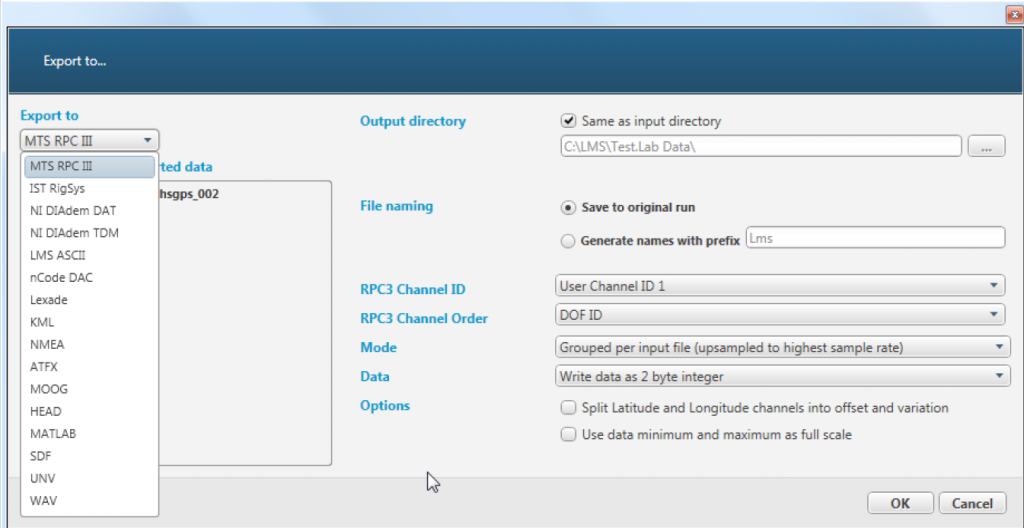
Simcenter SCADAS XS: Everything you need to know!
The Simcenter SCADAS XS (formerly LMS SCADAS XS) is a handheld data acquisition system (Figure 1).
It is capable of acquiring dynamic data simultaneously at 50,000 samples per second on up to 12 dynamic channels. There is a built-in battery which allows autonomous operation, or data can be acquired with a host PC.

Features
The SCADAS XS has the following inputs (Figure 2) and features:

Inputs
Interfaces
Size and Weight
A multi-pin LEMO connection is used in the dynamic voltage/ICP channels of the SCADAS XS. Each multi-pin LEMO connection accepts three voltage/ICP channels. A multi-pin LEMO connector to three BNC output breakout cable (Figure 3) is included for each input.

While the BNC breakout cable is useful for microphones or uniaxial accelerometers, there is a single cable option available for triaxial accelerometers. Several accelerometer manufacturers make a single cable (with multiple wires inside) that allow all three channels of a triaxial accelerometer to be plugged into the LEMO connector of the SCADAS XS in one connection (Figure 4).

Included Accessories
With a Simcenter SCADAS XS, several items are included (Figure 5):

Delivered items include:
Binaural Headset
Siemens makes a binaural headset (Figure 6) that plugs into a separate dedicated port on the SCADAS XS.
This headset has microphones positioned at both ears to make binaural recordings. Acquired data can also be listened to through the headset.

The product code for the headset is SCx-ABH04. Specifications are attached at end of article.6 or 12 Voltage/ICP Channels
Users can decide between a 6 or 12 voltage/ICP channel version of the SCADAS XS. All other channels (GPS, CAN-bus, etc.) are included in both versions.
Modes of Operation
The SCADAS XS supports different modes of operation:
USB-Based Frontend with Simcenter Testlab
The SCADAS XS can be used in ‘frontend mode’ with a host PC. It is connected the host PC (with Simcenter Testlab software) over a single USB connection (Figure 7), which both powers the SCADAS XS and streams data from it. In this configuration, all data is stored and viewed on the PC.

With Simcenter Testlab software on the PC, data acquisition like impact measurements, rotating machinery, and transient events can be used to acquire data. A large variety of analyses can be performed on this data from Modal Analysis, Operational Deflections Shapes, to Transfer Path Analysis.
Tablet with Simcenter Testlab Scope App software
The SCADAS XS can be controlled wirelessly from a tablet with Android based operating system. After installing the Simcenter Testlab Scope App software, acquisition can be setup, started, and stopped. This is done through built-in Wi-Fi on the SCADAS XS with a direct wireless connection to the tablet (Figure 8).
The tablet software capability includes test setup, data recording, data display, data replay, and export to Excel. Data in this mode is recorded to the onboard MicroSD card.

The wireless features allows an operator to walk around a test object with the tablet and see the data being collected, unencumbered by transducer cables (Figure 9).

The acquisition can also be started via the tablet with the Scope App. Once the acquisition is in progress, the Scope App can be closed while the acquisition continues (Figure 10).

This allows the measurement operator to not have to be with the test object at all times. For example, the engineer can remain on the ground while an experimental aircraft performs dangerous maneuvers. After the plane returns to ground, the engineer starts the Scope App and can reconnect to the acquisition in progress. The engineer can then stop the measurement, and review the data.
Data can also be processed using the Scope App. Analyses include spectrums, octaves, colormaps, loudness, orders, and more (Figure 11).

Analysis results can either be exported to Excel, or recorded via screen capture.
Standalone
With a pre-defined acquisition template, users can press the record button on the SCADAS XS itself to start and stop the measurement to the onboard MicroSD card – no tablet or PC is necessary (Figure 12). This is the simplest mode of operation.

Complete standalone mode is helpful for untrained users. For example, a machine operator is hearing a strange noise from equipment on occasion. A microphone recording template can be loaded on the SCADAS XS and sent to the machine operator. When the noise is heard, the operator simply clicks the record button to capture it.
With a headset connected, they can press the “Replay” button to verify that the sound was captured. The data they can then be downloaded by an expert user for detailed analysis.
Data Conversion Software
Data collected in SCADAS XS standalone mode is not required to be analyzed by Siemens Simcenter software. A license-free data conversion software tool (Figure 13) is included with the SCADAS XS. Data acquired by the SCADAS can be exported to other file formats to be analyzed with non-Siemens tools.

Application Cases
The SCADAS XS can be used in many different data collection scenarios. A few application cases are listed below: